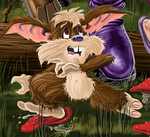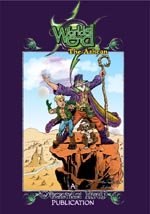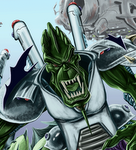Has Digital Replaced Traditional?
I was recently given a couple of cuttings, by my Wife’s Aunty, from the Guardian newspaper, published here in the UK (within the last six months now is recent to me, with all the workload) and I thought I would share it with you all. If you have seen the pieces already, then please accept my apologies for perhaps going over old ground, but for those of you that haven’t, then I hope it’s of interest…
The main gist of the initial piece was that in the eyes of the author of the piece (an author in need of some original, traditionally produced art for the cover of her latest book at the design stage) the designers of the book cover, “like so many recent art school graduates were technologically nimble professionals that did not know how to draw.” Lionel Shriver wrote the piece in the 02.08.2006 issue of the Guardian. See I said I was suffering from “Tardis-itis”, yes things go by so fast at the moment, I just ask you to bear with me.
Anyhow the piece then went on to discuss at some length that unlike the past book covers Lionel had received on the books, which were hand painted (one of which involved painting the heads of the authors characters on the background of Henri Rousseau’s “The Dream”) would no doubt be produced now using photographs.
She then goes on to say that the second cover “used traditional artwork of a moon rock with two crossed drumsticks and a joyful splatter of paint”. All latter covers had subsequently capitulated to the computer in her eyes, however.
She then goes on to say that this problem is not exclusive to book covers, but is right across the board with designers of everyday objects now working in pixels, adding that, “the designers and artists of today don’t get chalk dust on their shirts, they don’t get paint under their nails.” There is further implication from her in the piece whereby the human warmth of the artwork is lost as the computer makes the work seem cold and lifeless.
The second piece written in response to this is by, Tom Jones of the University of Central England and goes something like this, “Whilst it is sad that Lionel Shriver cannot get designers to provide a hand-drawn cover illustration for her new novel, she mistakenly attributes the causes of her problem.”
He goes on to add, “Current design graduates do indeed know how to draw because they are still taught to do so. The problem is that current concepts and practices in drawing differ from the “funky folk art” view she propounds.” He uses this in parenthesis in direct quotation, although to my mind a little disingenuously, in response to her using remarks on “retro”, “Joni Mitchell” and “designers of yore creating their own funky folk art”.
After more explanations regarding today’s approach by designers he then ends his response to her earlier piece by saying, “This professional approach to drawing has nothing to do with mushily responding to “the tender, human feel of error”, nor does it necessarily produce beguiling watercolour images of everyday objects. Drawing constitutes a disciplined and hard-won skill in correlating hand, eye and critical judgement to create visual images in two dimensions.”
The uniqueness created by artists and their ability to draw things asymmetrically and “with error” are what differentiates between these creative skills utilised by human beings and those of the artificial intelligence used by the computer.
Life is not perfect and we are not used to seeing perfection in our visualisation of the world around us. The computer, however exists to create perfection, it is a mirror of its true self and is in fact in direct opposition to our viewpoint of the world. The computer cannot give mankind imperfection, unless programmed to do so.
Although on a lighter note, I would like to be reminded of this statement the next time a computer decides to throw its teddy in the corner and malfunction…just prior to deadline.
Now whilst both points of view are valid, they both argue around the garden path in my eyes. On the one hand we have an author saying she cannot find guys today that can draw traditionally and on the other we have a lecturer telling her that today’s students do indeed learn traditional drawing techniques but then argues against the case that there is human warmth in traditional skills and then almost dismissively states that these skills don’t have to make beguiling watercolour images, almost as if this is a demeaning thing to achieve.
Coming from the position of both artist/designer and lecturer I see the holes in both their arguments. As far as finding guys that can draw traditionally still, this is nonsense, if Lionel were meaning these skills have been lost over to the computer – but I feel this isn’t her real argument at all, but has received a response to it as one would expect in today’s art and design climate.
Had she approached artists or artists/designers, instead of as I suspect designers, then she would have found there are still guys like us that can work when the power goes down or the computer crashes. I don’t feel that she didn’t do this, however but is pointing out some truths to the piece.
This differentiation between artists, artist/designers and designers is certainly there for all to see and as I know lots of folks that would fit into one or the other category, I feel this validates the differentiation.
As Far as Tom is concerned he is defending the educational content of the argument. But his seeming disdain for the traditional ways seems a little harsh and I cannot for one second think that the beguiling artwork of the Pre-Raphaelites and such does not move him in any way, despite his implication to the opposite.
As a guy in the arts industries I see evidence all the time of guys leaving educational institutions with no traditional drawing skills, but that are wiz-kids on the computers. My experience through speaking to many lecturers from many such institutions is this; most graphics courses now contain almost (at best) no life drawing or traditional drawing training of any kind.
The only ways to learn these skills nowadays are to join life-drawing classes, external to the main course, do fine art (and even this is, in the main, the study of modern art techniques and not figurative ones, in the traditional sense of leaning the skills of the old masters) or study illustration after first studying one of the previous ones, preferably one in graphics.
The new graphics courses are filled with computer terminals and teach students how to work wonders on them. So there are elements of truth to both pieces, really, but I think the real truth lies with this: If someone is truly creative and has the traditional skills under the proverbial belt, then the transition to painting digitally is easier than if one was to train someone who is a wiz on the computer to control and manipulate “real” wet medium such as watercolours, oils, acrylics, etc, etc.
The trouble with a lot of today’s artwork done digitally and here I differentiate between 2D and 3D, which I am discounting from this particular Blog (not to be dismissive, but rather to create a difference between the technology knowledge levels and skills required) is exactly as Lionel puts it having no warmth, or feeling, or emotion to it. This is, I must point out here, not always the case, however, and is largely down to the skill level of the individual creative in question, as is always the case.
In a lot of cases designers, rather than artists, in the truest sense, are dependant on the capabilities of the computer, which lends a superficial air to its content often times and also causes it, in its perfection (please remember in the main, computers are perfect in their application) to lack soul and warmth and energy and in many cases to become formulaic.
Again, this is down to the individual artist/designer. Some can produce traditional and digital renditions, whilst others, and here I really do feel it is the case of the newly graduated, although not in all cases, that do not have these dual skills.
The reason for this is simple to me for any true creative to obtain these skills, just like Tom says in his piece, one must become disciplined and work hard to gain hard-won skills in correlating hand, eye and critical judgement to create visual images in two dimensions.
These skills are honed over many years, both studying and experimenting until they become second nature and as vital, natural and important as breathing. So the way I see it both guys are right, but both equally wrong. Some folks are adept at both digital and traditional, whilst others at one or the other. Neither makes for a better creative.
At the end of the day what is important is that the integrity of the artist/designer is kept and they are allowed to express themselves freely and without constraint, in the first instance. This enables them to explore as many avenues as possible, allowing them to find the absolute in their work, which in turn makes them each unique, rather than have manufactured, unemotional and none evocative artwork and designs that do nothing to either inspire or serve to make others think…
Tim Perkins…
February 13th 2007
How to search this blog
1 month ago












































1 comment:
The short version here is that the computer is a tool, just like any other tool, and it has its good points as well as its bad and that is simply its nature. to dismiss a tool outright is a mistake that traditionalists should be keen not to make. We master our skill and, more importantly, our eye over years and years of work, both as illustrators and designers, that is what makes us good at what we do.
The ability, the strength of the computer is it's revisionist capabilities. Don't like that color in photoshop? delete it and move on to a new one. Couldn't do that with oil paints, or watercolour. Sadly, it can lack some of the warmth of the hand drawn, but with teh advent of the wacom tablet and some great advances in photoshop and illustrator, we can see a real change in how the computer can be perceived.
BTW - Tim, for gods sakes, put some space between your paragraphs! Makes my eyes go bonkers!
Post a Comment